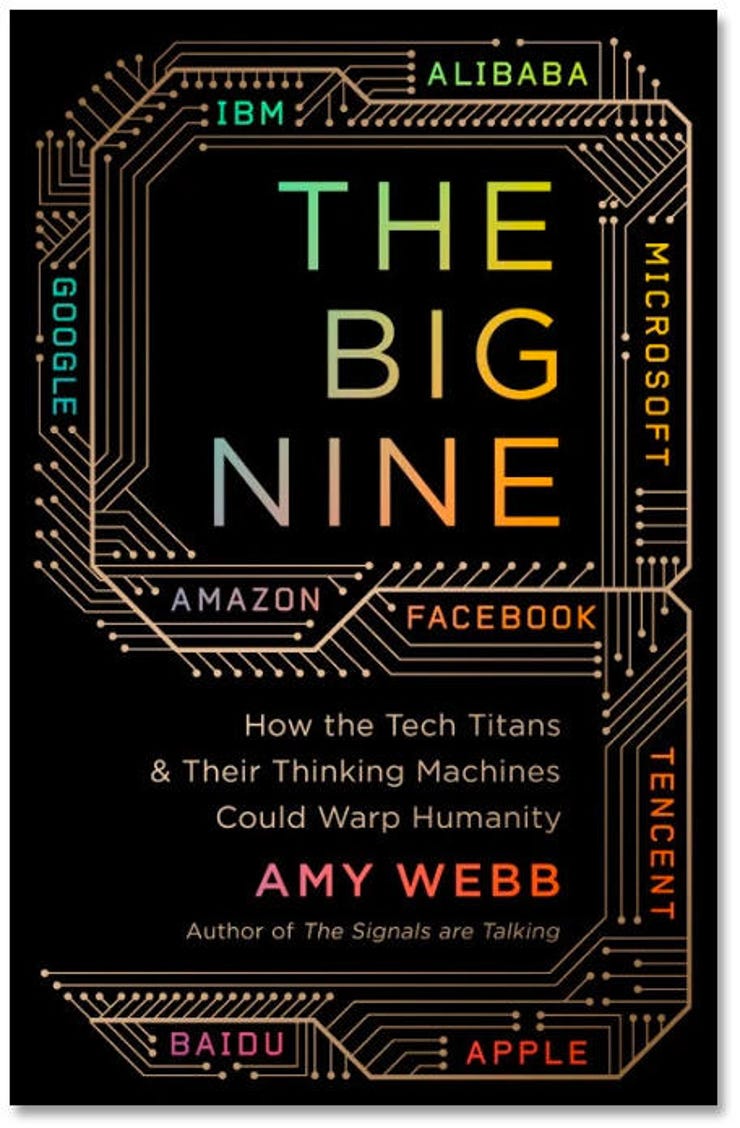The Big Nine, book review: Visions of an AI-dominated future


The Big Nine: How the Tech Titans and Their Thinking Machines Could Warp Humanity • Amy Webb • PublicAffairs • 320 pages • ISBN: 978-1-5417-2441-9 • £13.99
In her more paranoid books, Agatha Christie imagined that the world was being secretly and deliberately destabilised by a handful of unknown characters up to nothing good for the rest of us. In The Big Four, for example, the titular four were the good guys, building a case against secret, stateless agitators.
The story Amy Webb tells in The Big Nine: How the Tech Titans and Their Thinking Machines Could Warp Humanity offers a modern parallel: the development of artificial intelligence, a technology with profound and difficult-to-control consequences for all of humanity, is being largely left in the hands of just nine large companies worldwide. In one corner, Webb places the US, with Google, Apple, Facebook, Amazon, Microsoft, and IBM (G-MAFIA); in another corner resides China's Baidu, Alibaba and Tencent (BAT). Are they going to band together to destabilise the world or to save it?
In the first quarter of the book, the West appears doomed. China's huge domestic market and pervasive surveillance gives it uniquely huge piles of the training data that AI researchers need, fuelled by government policy that's pouring huge resources into making the country into the world leader.
SEE: How to implement AI and machine learning (ZDNet special report) | Download the report as a PDF (TechRepublic)
The US used to invest on this kind of grand scale (the moon landing, for example), but the present withdrawal in favour of private investment is leaving the global field wide open.
China is taking full advantage, pushing its technology and funding infrastructure across Africa and the Middle East. Internet pioneers talked about exporting democratic principles alongside the technology. But having reinvented the internet in its desired intranet image, China is now exporting its very different vision across the world to countries that either lean in a similar authoritarian direction or are willing to accept it in return for the technological benefit. BAT, Webb writes, are not held back by either privacy laws or the squeamishness that has led researchers at Google and Amazon to press their companies to back away from contracts selling their work to military, police, and immigration enforcement customers.
Although Webb does not say this, G-MAFIA's vision is not as different from China's as it might be: a recent Fast Company article noted the parallels between China's nascent social credit system and the commercial systems Silicon Valley is building. Only the motive is different.
Good, bad and ugly
And this is where Webb's analysis begins to fail. The middle half of the book is occupied by three scenarios covering the coming 30 to 50 years. In the first, AI is harnessed to benignly manage our lives. In the second it develops chaotically, much like the internet, and the Western world splits into technology vendor-defined tribes. In the third, China wins and eventually uses its AI hegemony first to wall in and then to exterminate all Americans to give its own population more space.
The first of these scenarios is supposed to be the 'good' version: worldwide collaboration on ethical principles, the formation of a global oversight body (GAIA), and AI harnessed to oversee all aspects of our lives to our benefit. Personally, I'm not sure how much better I'd like this level of centralised control than being exterminated by a Chinese AI because it wants my house for a Tanzanian family.
SEE: Microsoft: We want you to learn Python programming language for free
Webb concludes with a set of principles GAIA should adopt and promulgate. Yet so much is missing. In 50 years, climate change could force a rethink on increasing computer dependency. More important, Webb doesn't consider the potential for a countervailing AI initiative equivalent to the open-source movement or a shadow criminal AI infrastructure that even now could be taking shape based on stolen and leaked data. If the criminal underground can, as it has, build an entire shadow software economy with free trials, customer service, technical support, and a research division scouring software for zero days to exploit, why wouldn't it be also building its own AI?
Webb's main point, however, is that none of this is inevitable. We have choices to make -- at least for now -- and we should put thought into making them.
RECENT AND RELATED CONTENT
More generic futurist hand-waving from Huawei's founder
See Spot go: Boston Dynamics shares new video of its robot dog at work
Boeing to develop AI systems with Defence's autonomous research centre
AI and ethics: The debate that needs to be had
These 10 technologies are most likely to help save planet Earth
Read more book reviews
- Tools and Weapons, book review: Tech companies, governments and smart regulation
- The Smart-Enough City, book review: Putting people first
- The Twenty-Six Words that Created the Internet, book review: The biography of a law
- The Science of Breaking Bad, book review: Walter White's chemistry explained
- Robotics Through Science Fiction, book review: New insights from old stories